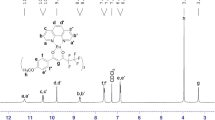Abstract
A diphenyl-boron β-diketonate complex was synthesized. Its photophysical properties were studied in solution and in the solid-state, and compared to those of its parent diketone and the corresponding difluoro-boron complex. TD-DFT calculations show that the molecular orbitals involved in the first Franck–Condon transition are very different for the three compounds studied. The difluoro-boron complex is strongly fluorescent in solution, and remains fluorescent in the solid-state. The free diketone turns to be very weakly fluorescent in solution and displays significant Aggregation Induced Enhanced Emission (AIEE) in the crystalline state, which can be explained by a rigidification of the molecule, while the diphenyl-boron complex is weakly fluorescent in solution as well as in the solid-state. For the free diketone and the difluoro-boron complex a mechanofluorochromic response is observed upon grinding the crystalline powder in a mortar, while for the diphenyl-boron complex no fluorescence emission change is detected under these conditions. Overall, this study shows that the nature of the chelating group has a crucial influence on the photophysical and mechanofluorochromic properties of β-diketonate complexes, leading to a wide variety of behaviors within the closely related structures of such derivatives.
Similar content being viewed by others
References
J. Xu and Z. Chi, Mechanochromic Fluorescent Materials: Phenomena, Materials and Applications, The Royal Society of Chemistry, 2014.
P. Xue, J. Ding, P. Wang and R. Lu, Recent progress in the mechanochromism of phosphorescent organic molecules and metal complexes, J. Mater. Chem. C, 2016, 4, 6688–6706.
Y. Sagara, S. Yamane, M. Mitani, C. Weder and T. Kato, Mechanoresponsive Luminescent Molecular Assemblies: An Emerging Class of Materials, Adv. Mater., 2016, 28, 1073–1095.
C. Calvino, L. Neumann, C. Weder and S. Schrettl, Approaches to polymeric mechanochromic materials, J. Polym. Sci., Part A: Polym. Chem., 2017, 55, 640–652.
G. Zhang, J. Lu, M. Sabat and C. L. Fraser, Polymorphism and reversibIe mechanochromic Iuminescence for solid-state difIuoroboron avobenzone, J. Am. Chem. Soc., 2010, 132, 2160–2162.
T. Sagawa, F. Ito, A. Sakai, Y. Ogata, K. Tanaka and H. Ikeda, Substituent-dependent backward reaction in mechanofluorochromism of dibenzoylmethanatoboron difluoride derivatives, Photochem. Photobiol. Sci., 2016, 15, 420–430.
A. Sakai, E. Ohta, Y. Yoshimoto, M. Tanaka, Y. Matsui, K. Mizuno and H. Ikeda, New Fluorescence Domain “Excited Multimer” Formed upon Photoexcitation of Continuously Stacked Diaroylmethanatoboron Difluoride Molecules with Fused pi-Orbitals in Crystals, Chem. - Eur. J., 2015, 21, 18128–18137.
P. Galer, R. C. Korosec, M. Vidmar and B. Sket, Crystal structures and emission properties of the BF(2) complex 1-phenyl-3-(3,5-dimethoxyphenyl)-propane-1,3-dione: multiple chromisms, aggregation- or crystallization-induced emission, and the self-assembly effect, J. Am. Chem. Soc., 2014, 136, 7383–7394.
W. A. Morris, T. Liu and C. L. Fraser, Mechanochromic luminescence of halide-substituted difluoroboron β-diketonate dyes, J. Mater. Chem. C, 2015, 3, 352–363.
S. Xu, R. E. Evans, T. Liu, G. Zhang, J. N. Demas, C. O. Trindle and C. L. Fraser, Aromatic difluoroboron beta-diketonate complexes: effects of pi-conjugation and media on optical properties, Inorg. Chem., 2013, 52, 3597–3610.
T. Butler, W. A. Morris, J. Samonina-Kosicka and C. L. Fraser, Mechanochromic Luminescence and Aggregation Induced Emission of Dinaphthoylmethane beta-Diketones and Their Boronated Counterparts, ACS Appl. Mater. Interfaces, 2016, 8, 1242–1251.
W. A. Morris, T. Butler, M. Kolpaczynska and C. L. Fraser, Stimuli Responsive Furan and Thiophene Substituted Difluoroboron beta-Diketonate Materials, Mater. Chem. Front., 2017, 1, 158–166.
F. Wang, C. A. DeRosa, M. L. Daly, D. Song, M. Sabat and C. L. Fraser, Multi-stimuli responsive luminescent azepane-substituted β-diketones and difluoroboron complexes, Mater. Chem. Front., 2017, 1, 1866–1874.
T. Butler, F. Wang, M. Sabat and C. L. Fraser, Controlling solid-state optical properties of stimuli responsive dimethylamino-substituted dibenzoylmethane materials, Mater. Chem. Front., 2017, 1, 1804–1817.
J. Hu, Z. He, Z. Wang, X. Li, J. You and G. Gao, A simple approach to aggregation-induced emission in difluoroboron dibenzoylmethane derivatives, Tetrahedron Lett., 2013, 54, 4167–4170.
L. Wang, K. Wang, B. Zou, K. Ye, H. Zhang and Y. Wang, Luminescent chromism of boron diketonate crystals: distinct responses to different stresses, Adv. Mater., 2015, 27, 2918–2922.
M. Louis, A. Brosseau, R. Guillot, F. Ito, C. Allain and R. Métivier, Polymorphism, Mechanofluorochromism, and Photophysical Characterization of a Carbonyl Substituted Difluoroboron-β-Diketone Derivative, J. Phys. Chem. C, 2017, 121, 15897–15907.
G. M. Sheldrick, SHELXS-97, Program for Crystal Structure Solution, University of Göttingen, Göttingen, Germany, 1997.
G. M. Sheldrick, Acta Crystallogr., Sect. A: Found. Crystallogr., 2008, 64, 112–122.
L. J. Farrugia, J. Appl. Crystallogr., 1999, 32, 837.
M. J. Frisch, G. W. Trucks, H. B. Schlegel, G. E. Scuseria, M. A. Robb, J. R. Cheeseman, G. Scalmani, V. Barone, G. A. Petersson, H. Nakatsuji, {etet al.}, Gaussian 09, Gaussian, Inc., Wallington CT, 2009.
L. Wang, Z. Zhang, X. Cheng, K. Ye, F. Li, Y. Wang and H. Zhang, Red emissive diarylboron diketonate crystals: aggregation-induced color change and amplified spontaneous emission, J. Mater. Chem. C, 2015, 3, 499–505.
R. L. Martin, Natural transition orbitals, J. Chem. Phys., 2003, 118, 4775–4777.
A. Nagai, K. Kokado, Y. Nagata, M. Arita and Y. Chujo, Highly intense fluorescent diarylboron diketonate, J. Org. Chem., 2008, 73, 8605–8607.
G. Zhang, J. P. Singer, S. E. Kooi, R. E. Evans, E. L. Thomas and C. L. Fraser, Reversible solid-state mechanochromic fluorescence from a boron lipid dye, J. Mater. Chem., 2011, 21, 8295.
Acknowledgements
This project has received funding from the European Research Council (ERC) under the European Union’s Horizon 2020 research and innovation programme (grant agreement No 715757 MECHANO-FLUO to C. A.) and from the IDEX Paris-Saclay (Ph. D. fellowship to M. L.).
Author information
Authors and Affiliations
Corresponding authors
Rights and permissions
About this article
Cite this article
Louis, M., Guillot, R., Métivier, R. et al. β-Diketone derivatives: influence of the chelating group on the photophysical and mechanofluorochromic properties. Photochem Photobiol Sci 17, 822–828 (2018). https://doi.org/10.1039/c8pp00070k
Received:
Accepted:
Published:
Issue Date:
DOI: https://doi.org/10.1039/c8pp00070k




